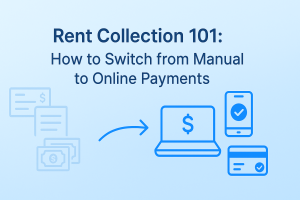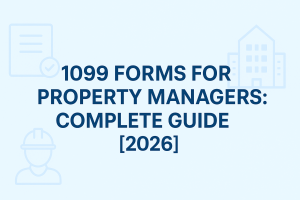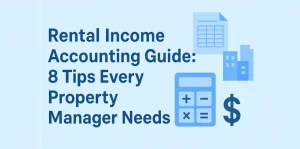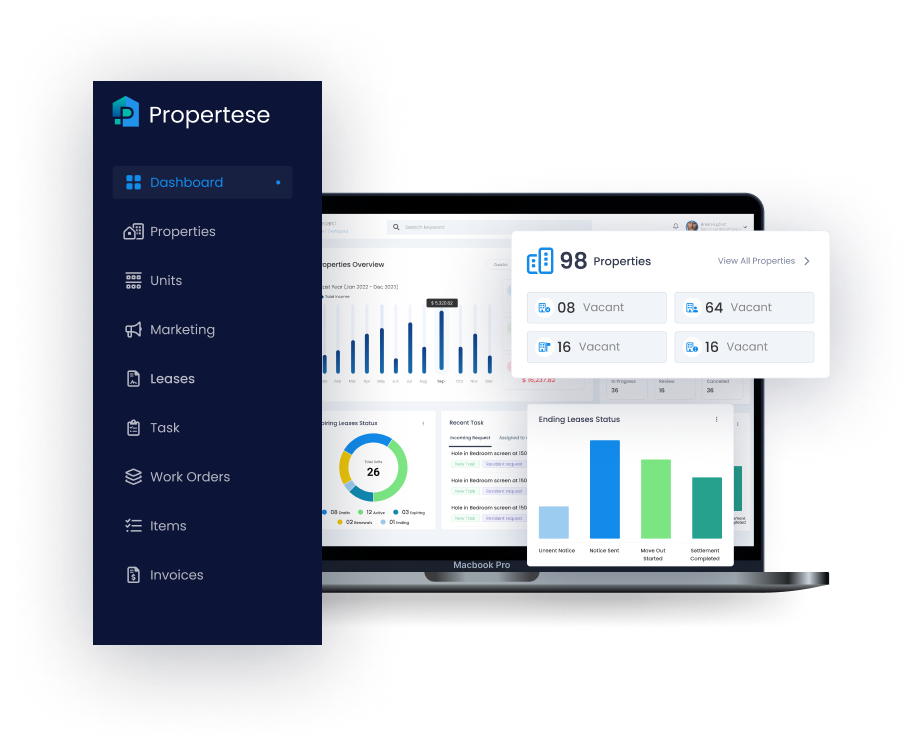
The most effective strategies are implementing comprehensive property management software with automation, diversifying your portfolio across property types, optimizing tenant retention through digital experiences, and leveraging data-driven pricing strategies. 91% of property management companies plan portfolio expansion in 2025, with the market growing from $81.52 billion to $98.88 billion by 2029.
How fast should a property management business grow?
Sustainable growth of 15-30% annually is optimal for property management businesses. Companies growing faster than this often experience service quality decline and operational challenges that hurt long-term profitability.
Property Management Industry Growth 2025
Key statistics driving the future of property management
Why do most property management companies struggle to grow?
Most property management companies fail to grow because they focus on acquiring new clients without optimizing their operations first. They lack integrated systems, proper automation, and scalable processes to handle growth efficiently.
What causes property management business growth to plateau?
Growth plateaus occur when companies scale too quickly without comprehensive property management software, adequate staff training, or automated workflows. This leads to service quality decline, client churn, and operational bottlenecks that prevent sustainable expansion.
How much can you realistically grow your property management business?
Most successful property management companies grow between 15-30% annually. Companies managing 101-500 units represent 35% of the market, while the largest companies manage up to 798,272 units.
What are the current property management industry growth trends?
2025 Growth Data:
- 91% of property management companies plan portfolio expansion
- 31% plan to expand into new property types
- 23% plan geographic expansion
- Industry employment grew 29.1% between 2022-2023
- Market projected to reach $98.88 billion by 2029
How can AI automation help grow a property management business?
AI can increase property management team productivity by 40% and reduce lease administration errors by 42%. AI automates tenant screening, rent pricing, maintenance scheduling, and customer service, allowing companies to scale without proportionally increasing staff.
Learn more about how AI integration in property management software is transforming the industry.
What AI tools do property managers actually use for growth?
Practical AI Applications:
How does AI improve tenant screening?
- Automated background checks and credit analysis
- Predictive tenant scoring and property matching
- Reduces screening time by 75% while improving accuracy
How can AI provide 24/7 customer service?
- AI chatbots reduce response times to 3-5 minutes
- Handle routine inquiries and maintenance requests automatically
- Capture every lead and never miss potential tenants
How does AI optimize rental pricing?
- Analyzes market data and competitor pricing in real-time
- Automatically adjusts rent based on demand and seasonality
- Maximizes revenue while maintaining optimal occupancy rates
How does AI prevent maintenance emergencies?
- Predictive maintenance reduces emergency repair costs by 25%
- IoT sensors monitor HVAC, plumbing, and electrical systems
- Schedules preventive maintenance before failures occur
How do you implement AI in property management step-by-step?
AI Implementation Timeline
Your step-by-step guide to automating property management operations
- Automated email communication
- Rent payment reminders
- Property inquiry management
- Intelligent workflow setup
- Automated lead management
- Digital lease workflows
- Approval process automation
- Tenant screening systems
- Work order automation
- Vendor management systems
- Predictive maintenance
- Cost tracking & analytics
- Vacancy rate tracking
- Revenue optimization
- Comprehensive reporting
- Performance analytics
4-Step Implementation Process:
Week 1-2: How to start with AI-powered communication?
Action Steps:
- Implement automated email communication systems
- Set up automated rent payment reminders
- Configure property inquiry and viewing automation
- Deploy intelligent workflow management
Week 3-4: How to automate your leasing process?
Implementation Steps:
- Launch automated leads and rental applications management
- Set up digital lease management workflows
- Implement approval workflow automation
- Configure tenant screening automation
Month 2: How to streamline maintenance operations?
Operational Setup:
- Deploy maintenance request management systems
- Set up automated work order processing
- Implement vendor management automation
- Configure predictive maintenance scheduling
For comprehensive maintenance management, explore Propertese’s maintenance and work order management capabilities.
Month 3: How to optimize portfolio performance?
Performance Optimization:
- Implement vacancy and occupancy tracking automation
- Set up automated rent collection systems
- Deploy comprehensive reporting dashboards
- Configure portfolio analytics and insights
How should property managers diversify their portfolios for growth?
31% of property management businesses plan to expand into new property types, while 23% plan geographic expansion. Smart diversification reduces risk and creates multiple revenue streams.
What property types offer the best growth opportunities?
High-Growth Property Categories:
How profitable are short-term rentals for property managers?
- Higher revenue per unit than traditional rentals
- Growing demand for professional Airbnb management
- Requires specialized short-term rental management software
- Technology enables efficient remote management
Why is student housing a good growth market?
- Stable, predictable income from semester-based leases
- Higher rent per bedroom compared to family housing
- Built-in tenant turnover creates ongoing opportunities
- Requires specialized leasing and communication systems
Learn about specialized student housing management software solutions designed for this unique market.
What makes senior living properties attractive?
- Aging population creates massive demand growth
- Longer tenancy periods reduce turnover costs
- Higher profit margins due to specialized services
- Requires advanced maintenance and communication management
How can property managers enter commercial management?
- Higher management fees and longer lease terms
- Less day-to-day management than residential properties
- Requires different skill sets and software capabilities
- Offers portfolio diversification and stability
Explore how commercial property management differs from residential and what tools you need to succeed.
Which geographic expansion strategies work best?
Smart Geographic Growth:
Why target secondary markets first?
- Lower competition than primary metropolitan markets
- Better rent-to-purchase price ratios for investors
- Easier to establish market leadership position
- Often overlooked by larger management companies
How to manage properties remotely?
- Virtual property tours and inspection technology
- Remote tenant screening and digital leasing
- Local contractor networks for maintenance
- Cloud-based property management software essential
What partnerships support geographic expansion?
- Local real estate agents for market knowledge
- Regional contractors for maintenance services
- Area property attorneys for legal compliance
- Local vendors for specialized services
What technology do you need to scale a property management business?
Comprehensive property management software reduces operating costs by 15% and enables sustainable scaling. Cloud-based platforms with integrated features are essential for growth.
What are the must-have property management software features?
Core Platform Requirements:
What portfolio management features are essential?
- Multi-property oversight with centralized dashboards
- Property and unit management across different types
- Advanced reporting and analytics for decision-making
- Localization features for multi-market operations
- Scalable architecture that grows with your business
Discover how portfolio management tools can centralize your operations and improve efficiency.
What leasing features accelerate growth?
- Automated leads and rental applications management
- Digital lease management with electronic signatures
- Property listings and outreach automation
- Move-in and move-out process management
- Efficient lease renewal and approval workflows
Learn how efficient lease management can streamline your leasing process and reduce vacancy periods.
What communication features improve efficiency?
- Automated email communication systems
- Dedicated tenant portal for self-service access
- Property owner portal for transparent reporting
- Automated rent payment reminders and notices
- Multi-channel communication coordination
What maintenance features reduce costs?
- Maintenance request management with work orders
- Automated vendor assignment and management
- Common area maintenance scheduling and tracking
- Preventive maintenance automation
- Approval workflows for maintenance expenses
How much should you budget for property management technology?
Technology Investment Pyramid
Strategic budget allocation for property management technology
Investment Guidelines:
What’s the ideal technology budget allocation?
- 40% – Comprehensive property management platform
- 25% – Communication tools and digital portals
- 20% – Financial systems and payment processing
- 15% – Specialized features and integrations
What ROI can you expect from property management software?
- 75% of companies see ROI within 12 months
- 15% reduction in operating costs through automation
- 40% improvement in team productivity
- Significant reduction in administrative overhead
How do you improve tenant retention for business growth?
Tenant turnover costs average $4,000 per unit for multifamily properties. Every tenant retained for an additional year significantly improves profitability and enables sustainable growth.
Tenant Retention ROI Analysis
The financial impact of keeping vs. replacing tenants
What do tenants expect from property management in 2025?
Modern Tenant Expectations:
What smart home features do tenants want?
- 54% of renters prefer properties with smart home features
- Smart locks and keyless entry systems
- App-controlled thermostats and lighting
- High-speed internet and WiFi infrastructure
- Package delivery management systems
How important is energy efficiency to tenants?
- 74% of renters prioritize energy-efficient properties
- LED lighting and energy-efficient appliances
- Smart thermostats and programmable systems
- Solar panels and renewable energy features
- Water-saving fixtures and systems
What digital experiences do tenants require?
- 80% of tenants prefer online rent payments
- Mobile-responsive tenant portal access
- Digital lease signing and renewal processes
- Online maintenance request systems
- 24/7 self-service capabilities
Understand how online rent payments and collections can improve cash flow and tenant satisfaction.
What tenant retention strategies actually work?
Proven Retention Methods:
How does automated communication improve retention?
- Automated email systems for regular updates
- Proactive rent payment reminders and notices
- Automated renewal notice systems
- Property inquiry and viewing coordination
- Digital document management for transparency
What value-added services retain tenants?
- Package delivery and management services
- Pet-friendly amenities and policies
- Fitness facilities or partnership programs
- Co-working spaces for remote workers
- Community events and tenant recognition
How do lease renewal incentives work?
- Rent discounts for multi-year lease commitments
- Property upgrades for renewing tenants
- Flexible lease terms for quality tenants
- Recognition programs for long-term residents
- Early renewal bonuses and incentives
Read our comprehensive guide on how to improve tenant retention with proven strategies that work.
Strategy #5: How to Increase Revenue from Your Existing Properties (Without Raising Rent)
The opportunity: 63% of companies plan to raise rents or resident-paid fees to cover increased costs, but smart property managers are finding additional revenue streams.
Revenue Streams Most Property Managers Miss:
Ancillary Services and Fees
- Pet fees and monthly pet rent
- Parking space rentals
- Storage unit fees
- Laundry facility revenue sharing
- Utility cost recovery programs
Value-Add Property Improvements with High ROI
- Garage door replacements (193.9% ROI), entry door replacements (188.1% ROI), and manufactured stone veneer replacements (153.2% ROI)
- Energy efficiency upgrades that reduce operating costs
- Smart home features that justify rent increases
- Amenity additions that attract premium tenants
Service Partnerships and Commissions
- Renter’s insurance partnerships
- Utility setup service fees
- Moving and cleaning service referrals
- Home maintenance and repair markups
Market Research and Competitive Pricing Through Technology
Automated Pricing Optimization:
- Track vacancy and occupancy rates across your portfolio
- Automated reporting on market trends and competitor analysis
- Comprehensive property listings management for optimal exposure
- Real-time rent collection data to inform pricing decisions
Systematic Rent Management:
- Automated renewal notices based on lease terms
- Online rent payments and collections with detailed tracking
- Portfolio management tools that identify rent optimization opportunities
- Reporting features that track revenue per unit and market performance
Strategy #6: Building Strategic Partnerships That Accelerate Growth
Why partnerships matter: The most successful property managers don’t work alone – they build networks that multiply their capabilities.
High-Value Partnership Categories:
Real Estate Professional Networks
- Realtor partnerships for referral business
- Property owners, HOAs, and prospective tenants discover your services quickly when you have strong referral networks
- Property investor group relationships
- Real estate attorney and CPA partnerships
Service Provider Alliances
- Preferred contractor networks with negotiated rates
- Maintenance and repair service partnerships
- Landscaping and cleaning service agreements
- Technology vendor relationships
Financial Service Partners
- Mortgage broker relationships for owner clients
- Property insurance specialists and bulk purchasing
- Investment advisors for portfolio optimization
- Banking partners for specialized financing
How to Build Profitable Partnerships:
Step 1: Define Your Value Proposition
- What unique value do you bring to partners?
- How can partnerships be mutually beneficial?
- What specific outcomes do you want to achieve?
Step 2: Create Formal Partnership Agreements
- Document roles, responsibilities, and expectations
- Establish compensation and referral structures
- Set performance metrics and review schedules
- Include termination clauses and procedures
Technology Solutions for Partnership Management:
- Third-party properties management capabilities for seamless partner integrations
- Subsidiary management features for complex business structures
- Access management controls for different partner access levels
- Comprehensive reporting to share performance data with partners
- Document management system for partnership agreements and contracts
Strategy #7: Content Marketing and SEO for Property Management Companies
The long-term play: 75% of clicks come from the top three organic results, and 91% of renters start their house hunt online.
SEO Keywords Property Managers Should Target:
Local SEO Keywords (High Priority)
- “[City] property management company”
- “[City] property manager”
- “Property management services in [City]”
- “[City] rental property management”
Service-Based Keywords
- “Tenant screening services”
- “Rental property maintenance”
- “Property management fees”
- “HOA management company”
Question-Based Keywords (Great for Blog Content)
- “How much does property management cost?”
- “What does a property manager do?”
- “How to evict a tenant”
- “Property management vs self-managing”
Content That Actually Drives Leads:
Educational Blog Posts
- Local market trend analysis and reports
- Property investment guides and resources
- Landlord-tenant law updates and compliance
- Property maintenance and improvement tips
Location-Based Content
- Creating State, County, and City Pages for Your Service Areas
- Neighborhood investment guides
- Local rental market analyses
- Area amenities and attractions
Service Explanation Pages
- Detailed descriptions of each service you offer
- Pricing information and fee structures
- Process explanations and timelines
- Client testimonials and case studies
Common Property Management Growth Mistakes (And How to Avoid Them)
Technology Implementation Mistakes:
Mistake #1: Choosing Fragmented Systems
- Problem: Multiple disconnected tools that don’t work together
- Solution: Choose comprehensive property management software with integrated portfolio management, leasing, maintenance, and reporting
Understand the difference between spreadsheets vs property management software and why integrated systems are essential for growth.
Mistake #2: Inadequate Training on System Features
- Problem: Underutilizing powerful features like automated workflows and reporting
- Solution: Invest in thorough training on all system capabilities including tenant portals, owner portals, and maintenance management
Mistake #3: Poor Data Migration Planning
- Problem: Losing important property and tenant data during system transitions
- Solution: Work with platforms that offer robust document management and data import capabilities
Growth Strategy Errors:
Mistake #4: Scaling Without Systems
- Problem: Service quality declines as portfolio grows
- Solution: Build scalable processes before adding new clients
Mistake #5: Ignoring Client Retention
- Problem: Acquiring new clients while losing existing ones
- Solution: Track and improve client satisfaction metrics
Mistake #6: Geographic Expansion Too Fast
- Problem: Spreading resources too thin across markets
- Solution: Master one new market before expanding to the next
How to Measure Property Management Business Growth (Key Metrics That Matter)
Financial Growth Metrics:
Revenue Growth
- Year-over-year revenue increase
- Revenue per unit managed
- Average monthly revenue per client
- Gross profit margins
Cost Management
- Cost per unit managed
- Operating expense ratios
- Technology ROI measurements
- Staff productivity metrics
Operational Efficiency Metrics:
Client Satisfaction
- Net Promoter Score (NPS)
- Client retention rate
- Average client lifespan
- Referral rates and sources
Tenant Satisfaction
- Tenant retention rates
- Average lease renewal percentage
- Response time to maintenance requests
- Tenant complaint resolution time
Portfolio Performance
- Average vacancy rates
- Days on market for new listings
- Rent collection rates
- Maintenance cost per unit
Your 90-Day Property Management Growth Action Plan
90-Day Growth Action Plan
Your step-by-step roadmap to property management business growth
-
Week 1: Business AssessmentEvaluate current systems and identify integration opportunities
- Audit existing property management technology
- Review portfolio management efficiency
- Analyze communication effectiveness
- Assess maintenance processes
-
Week 2: System IntegrationDeploy comprehensive property management platform
- Implement core management software
- Set up automated rent collection
- Configure tenant and owner portals
- Initialize document management
-
Week 3: Leasing OptimizationStreamline leasing and communication processes
- Deploy leads management system
- Set up property inquiry coordination
- Configure email automation
- Implement approval workflows
-
Week 4: Performance MonitoringEstablish analytics and tracking systems
- Set up reporting dashboards
- Configure vacancy tracking
- Implement maintenance management
- Test all system integrations
-
Week 5-6: Service ExpansionDiversify offerings through technology
- Configure short-term rentals management
- Set up community association features
- Implement subsidiary management
- Deploy third-party properties capabilities
-
Week 7-8: Advanced FeaturesImplement sophisticated management tools
- Configure common area maintenance
- Set up localization features
- Implement access management
- Deploy move-in/out automation
-
Week 9-10: Performance EnhancementOptimize all systems for maximum efficiency
- Optimize property listings automation
- Fine-tune renewal workflows
- Enhance vendor management
- Analyze comprehensive reporting
-
Week 11-12: Growth PlanningPlan next phase using system insights
- Maximize platform feature utilization
- Implement advanced contract management
- Deploy comprehensive portal features
- Plan portfolio expansion strategy
Days 1-30: Foundation Assessment and AI Implementation
Week 1: Comprehensive Business and Technology Assessment
- Audit current property management systems and identify integration gaps
- Review portfolio management efficiency and reporting capabilities
- Analyze tenant and owner communication effectiveness
- Assess maintenance request management and work order processes
Week 2: System Integration and Automation Setup
- Implement comprehensive property management platform
- Set up automated rent payment reminders and collection systems
- Configure tenant portal and property owner portal access
- Initialize document management and digital contract workflows
Week 3: Leasing and Communication Optimization
- Deploy leads and rental applications management system
- Set up property inquiries and viewing coordination
- Configure email communication automation
- Implement approval workflows for leasing decisions
Week 4: Performance Monitoring and Analytics
- Set up comprehensive reporting and analytics dashboards
- Configure vacancy and occupancy rate tracking
- Implement maintenance and work order management systems
- Test all automated workflows and system integrations
Days 31-60: Service Expansion and Partnership Development
Week 5-6: Service Expansion Through Technology
- Configure short-term rentals management for diversification
- Set up community association management features
- Implement subsidiary management for complex structures
- Deploy third-party properties management capabilities
Week 7-8: Advanced Feature Implementation
- Configure common area maintenance tracking and billing
- Set up localization features for multi-market operations
- Implement advanced access management for different user roles
- Deploy move-in/move-out process automation
Days 61-90: Marketing and Growth Acceleration
Week 9-10: Optimization and Performance Enhancement
- Optimize property listings and outreach automation
- Fine-tune automated renewal notices and approval workflows
- Enhance tenant and vendor management processes
- Analyze comprehensive reporting for optimization opportunities
Week 11-12: Full System Utilization and Growth Planning
- Maximize use of all property management platform features
- Implement advanced contract management workflows
- Deploy comprehensive tenant portal and owner portal features
- Plan next phase of portfolio expansion using system insights
Frequently Asked Questions About Property Management Business Growth
15-30% annual growth is sustainable for most property management businesses. A larger segment of companies plan to grow by 25% or less compared to previous years because sustainable growth is more profitable than rapid expansion that breaks systems.
Comprehensive property management software with integrated portfolio management, automated workflows, and advanced reporting capabilities. Look for platforms that offer everything from tenant portals to maintenance management, as this foundation enables all other growth strategies.
Successful property managers spend 5-10% of revenue on marketing, with digital marketing (SEO, content, social media) typically delivering the highest ROI for service-based businesses.
It’s easier to manage different property types in your existing market than to learn new markets. Master single-family, multifamily, and commercial in your area before expanding geographically. Explore different property management markets including residential, commercial, and community association management.
Key indicators:
– Automated systems in place for rent collection and maintenance management
– Comprehensive reporting showing portfolio performance metrics
– Efficient tenant and property owner communication through digital portals
– Streamlined leasing processes with automated workflows and document management
– Scalable property management platform that can handle portfolio expansion
The #1 mistake is expanding the portfolio without having scalable systems in place. This leads to service quality decline, client churn, and ultimately, business failure.
Want to accelerate your property management growth?
The techniques outlined in this comprehensive guide represent proven strategies used by the most successful property managers in 2025. Start with one or two approaches that align with your current capabilities, then expand your strategy as you build momentum and see results.
Discover how Propertese can provide the comprehensive property management platform you need to execute these growth strategies successfully. From automated workflows to advanced reporting, we’ve got the tools to support your expansion plans. Schedule a demo today.
Table of Contents
Stay Updated
Subscribe to get the latest news, industry trends, blog posts, and updates...




